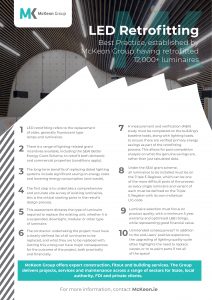Best Practice in LED Retrofitting
Best Practice in LED Retrofitting
11/12/2020
LED Retrofitting: Best Practice, as established by McKeon Group having retrofitted 12,000+ luminaires
Stephen Weir, MCIBSE IEng,Electrical Services Director, McKeon Group
LED retrofitting refers to the replacement of older, generally fluorescent type lamps and luminaires. The long-term benefits of replacing dated lighting systems include significant saving on energy costs and lowering energy consumption (and waste). There are numerous factors that influence what energy reduction a client can expect, such as building occupancy, controls type and existing luminaire type whether it be T8 or T5 type lamps. Having now retrofitted in excess of 12,000 luminaires, the Mckeon team are well familiar on the issues that can arise, particularly around the condition of the existing cabling infrastructure or indeed the condition of the emergency lighting, which does not fall under the SEAI grant scheme. While most emergency lighting installations are now designed with stand-alone luminaires rather than combined, there is still an opportunity for these to be updated.
Barriers to retrofitting: One of the persistent barriers to retrofitting is short-term thinking and the behaviour associated with that, specifically, the continued maintenance of outdated luminaires that are no longer fit for purpose, rather than replacing them with newer, more efficient fittings – despite considerable incentives to do so.
Incentives for retrofitting: There is a range of lighting-related grant incentives available, including the SEAI Better Energy Grant Scheme, to retrofit both domestic and commercial properties (conditions apply). Inclusion of commercial properties under this type of incentive scheme is a pioneering approach as similar grants in the UK are only available for domestic type projects, despite the fact that LED retrofitting is most beneficial and most impactful for commercial buildings.
LED retrofitting process: The first step is to undertake a comprehensive and accurate site survey of existing luminaires, this is the critical starting point in the retrofit design process. This assessment dictates the type of luminaire required to replace the existing unit, whether it is a suspended, downlight, modular or other type of luminaire. The contractor undertaking the project must have a clearly-defined list of all luminaires to be replaced, and what they are to be replaced with. Getting this wrong can have major consequences for the outcome of the project, both practically and financially. A measurement and verification (M&V) study must be completed on the building’s baseline loads, along with lighting loads, to ensure there are verified primary energy savings as confirmation to the retrofitting process. This allows for post-completion analysis on what the genuine savings are, rather than just tabulated data.
Luminaire selection: Luminaire selection must focus on product quality, with a minimum 5-year warranty and optimised L&B ratings, while representing good financial value. Under the SEAI grant scheme, all luminaires to be installed must be on the Triple E Register, which can be one of the more difficult parts of the process as every single luminaire and variant of each must be defined on the Triple E Register with its own individual LIG code.
Unintended consequences: In addition to the end-users’ positive experience, the upgrading of lighting quality quite often highlights the need to replace carpet, or to re-paint parts if not all of the space!
About McKeon Group:
Established in 1950, this year marks the 70th anniversary of McKeon Group, which remains a family business. ISO certified for more than two decades, McKeon Group offers expert construction, fitout and building services. The Group delivers projects, services and maintenance across a range of sectors for State, local authority, FDI and private clients. For more information, contact McKeon.ie

Recent Posts
Sustainability in the Construction Sector and Tendering Process
As the world turns its attention towards sustainability and combating climate change, industries are re-evaluating...
Read ArticleThe Importance of a Multi-Skilled Facilities and Maintenance Services Team
As companies compete in today's fast-paced business climate, having a well-maintained, efficient, and safe working...
Read ArticleBuilding the Future with BIM
Explore how Building Information Modelling (BIM) is paving the construction industry's future with its comprehensive...
Read Article
